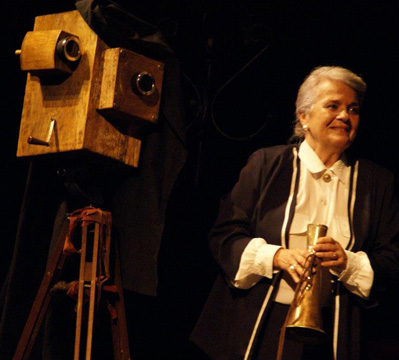A new play about Alice Guy, based on my book, her autobiography, and other sources is coming from Spain to New York, Miami, and Havana.
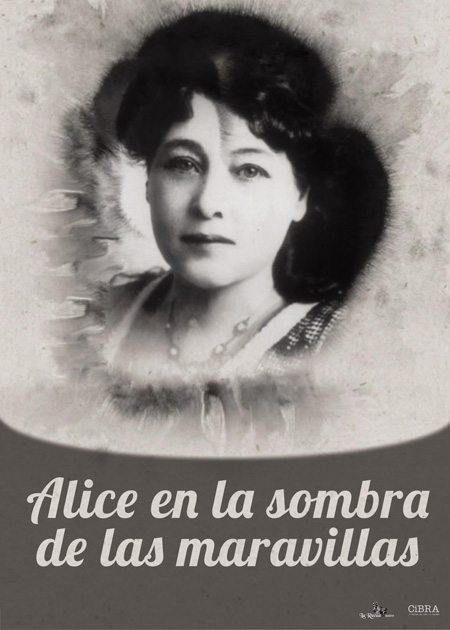
La Recua Teatro in Toledo, a company well known in Spain for their productions of Spanish Classics like La Celestina and Don Quixote (which is played out in Consuegra, the Castilian town famous for its windmills, and other similar locations) produced a play called Alicia en las Sombras de las Maravillas, partly inspired by my book on Alice Guy as well as the Memoirs and other sources. The title is a play on the Spanish translation of Lewis Carroll's Alice in Wonderland, it translates literarily as "Alice in the Shadows of Wonderland."
It's a lovely, lovely play. I saw the premiere in El Teatro de Rojas in Toledo, Spain, on November 22nd, 2012. A week later it played in Puebla de Montalban, near Toledo, which is where La Recua Teatro is based. La Recua plans to bring the play to New York, Miami and Havana. The play was directed by María Elena Diardes, a Cuban transplant to Toledo, and her husband, Luis María García.
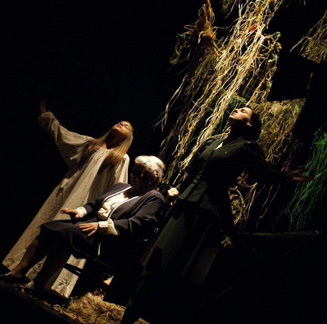
Elements of the play that stood out: three actresses play Alice Guy, one as a child, one as an adult, and one as an older woman. All three are on stage nearly all of the time.
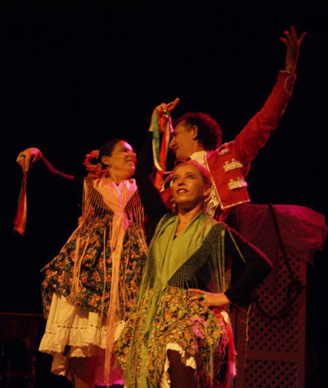
Three Spanish dancers that appear in the middle of the play are an acknowledgement of the fact that Alice Guy shot some films in Spain in 1905.
There is a very moving moment at the beginning of the play as the child Alice watches her father's shadow through a sheet, a play on the flickering nature of silent film images as well as the remoteness between Alice Guy and her father, which some relatives attribute to the fact that Emile Guy suspected Alice was the result of an affair between his wife and a ranch hand on their hacienda in Santiago, Chile.
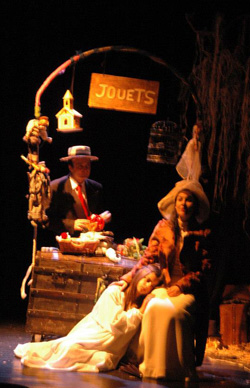
Another scene that really stood out for me is a meeting between Alice Guy and Georges Méliès after both had ceased to be filmmakers. In the play, Alice Guy visits Méliès toy shop in the Gare du Montparnasse in Paris and they have a conversation. In real life Alice Guy passed the toy shop and recognized Méliès, and felt terrible that the great director had been reduced to that, but did not speak to him. The fictionalized scene of that encounter is a moving reflection from both directors on how the industry they ushered into existence has now passed them by.
I asked the director to say write a few words about the play for this blog. Here is what she said:
"We worked on the project for more than nine months, making at least three drafts of the play. We took great care with the structure and the poetics of the text, we didn't want to stage a pedantic biography of Alice Guy, but rather our own poetic perspective on the events in her life. From the beginning I had three ideas firmly in mind which Luis developed in dramatic form:
1) the story would be narrated by three Alices, each with her own voice but interacting through the entire length of the play. I think we human beings are like that, no matter how old we are, we still carry the younger version of ourselves within us.
2) We wanted to stage movies as part of the play, to make a round trip from theatre to film and back to theatre. Alice did some theatre work in her youth, and the theatre was very important to her when she lived in the United States. She always surrounded herself with theatre people.
3) A key figure in our play would be another great, and once forgotten, director of early cinema: Georges Méliès. At this point in the play Alice has left the United States and returned to France after WWI, the end of her career, and the end of her marriage. I wanted her encounter with Méliès to occur just at the moment that she realizes her ties to the film industry are slipping away from her. She encounters Méliès in his toy store. They recognize each other right away but pretend not to. They speak for a few minutes, each telling the other their truths nobly and elegantly and with dignity. The world has changed around them but they are still themselves. As they speak Alice finds an old postcard announcing the Pantomimes Lumineuses from the Musée Grévin. Poor Pierrot!
The two of them are silent a moment, remembering Emile Reynaud, another artist devoted to early cinema, his pantomimes drowned in the Seine. [Reynaud created animated films before celluloid and has never really been credited for his accomplishments, partly because he dropped all of his own work into the Seine. Only two of his creations survive. You can see them here and here and documentary clips about his praxinoscope device here and here.]
That moment of silente reflection and respect for the luminous pantomimes is my favorite moment in the whole play.
After that instant of silence Méliès and Alice Guy look into each other's eyes and say each other's names out loud, with respect. It doesn't matter to them who made the first fiction film, who is the father or the mother of cinema, that history has made them competitors for that title and also companions in oblivion. What matters is that working in the cinema made them happy, that they both dedicated their lives to the magic of the shadows. Their dedication to the mystery of cinema is what joins them and what no one can take away.
At the end of the scene Méliès gives Alice a "toy" which is actually her Legion d'Honneur decoration.

What the play manages to convey, more than anything, is the impression that early films made on audiences, an impression aided by plentiful use of the kind of slapstick that was popular in early comedies (with abundant use of cross-dressing typical of early films and commented on in Alice Guy's films) and a soundscape filled with the trick-a-track noise of early film projectors.
The play featured original music by Sebastián Lorca y Ricardo Casas, who played the piano live in the performance that I saw. The lead actors were María Ladera,Soledad Chamón, Raquel de la Fuente,David López, Juan Erro, Angelines Ortiz y Fran Moreno.
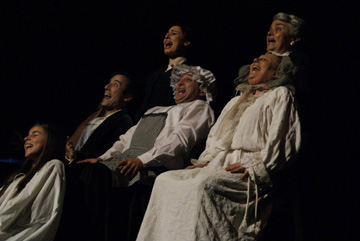
Best way to follow La Recua's activity is on FACEBOOK.
